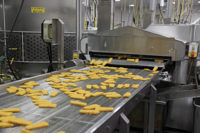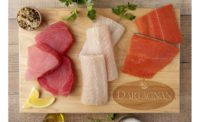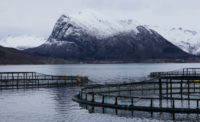Creating a sustainable seafood society
From white-tablecloth settings to home kitchens, High Liner Foods brings innovation and sustainably sourced seafood to the table.










Editor’s Note: This story originally published in Refrigerated & Frozen Foods magazine, a sister publication to The National Provisioner in BNP Media’s portfolio. www.refrigeratedfrozenfood.com
It used to be that seafood was only eaten in a sit-down restaurant, on the weekends, for special occasions. But, the economic downturn in 2008 forced consumers to reduce their expenditures and transform their spending habits. As a result, many Americans traded in their white tablecloth restaurant outings for ready-made meals eaten in the comfort of their own homes.
Fast forward to 2013, and shoppers can now “splurge” on that fancy seafood dish without having to empty out their bank accounts, and yes, they can do so in both restaurants and at home.
That’s because High Liner Foods is at the forefront of bringing seafood innovation to the table—albeit restaurant and at-home kitchens. In fact, this Nova Scotia, Canada-based company has taken the idea of “white-tablecloth seafood” and made it easy and convenient for consumers to put together at home. High Liner Foods provides new flavor profiles blended with traditional seafood fare coupled with extensive sustainability efforts, a host of company acquisitions and a plant expansion (see page 88). And, it ranked No. 18 in Refrigerated & Frozen Foods’ Top 150 Frozen Food Processors (March 2013 issue). These are just a few reasons why High Liner Foods was named Refrigerated & Frozen Foods’ 2013 Frozen Foods Processor of the Year.
There’s nothing fishy about seafood anymore
High Liner Foods remains on the cusp of emerging trends, as it amps up the frozen-food aisles with “white tablecloth” products. From sauced and seared to roasted and bronzed, High Liner Foods processes close to 2,000 SKUs of prepared, value-added frozen seafood for supermarkets, club stores, quick-service restaurants (QSR), K-12 schools, military, healthcare facilities, casual dining, national chains, businesses, catering, lodging and colleges/universities globally.
It’s the melding of the foodservice side of the food with retail-focused consumer trends that enable High Liner Foods to create the next best thing in the seafood aisles.
“In a lot of ways, it’s deductive. We’re seeing the chains with what they’re working on, which creates ideas. It startsat white tablecloth and goes down into casual dining and club stores, and then it drops down into family-style dining and finally QSR. By the time [the trend] has made its way down there, it’s a tried-and-true concept,” says Keith Decker, president and COO of High Liner Foods’ U.S. division, headquartered in Portsmouth, N.H.
Another reason why seafood has become a trending food option is the many health benefits it brings to the table.
“Seafood is becoming more and more popular as people become more focused on health,” says Chris Trosin, vice president of sales and marketing. “If you look at the seafood category in general, you’re definitely seeing a shift from a traditional bread-and-batter category with fish sticks and beer batter to items that are more culinarily interesting.”
Staying on top of trends also means introducing the right flavor profile at the right time. Flavors such as edamame, Ceviche and chipotle require appropriate timing in order to make the right impact with consumers, says Jeff Tahnk, director of retail marketing.
“If we launch [a flavor] too early, you’ll see OK sales on the club side. It’s when it starts to hit the mainstream foodservice areas that you’ll see great sales. It’s about timing it appropriately,” he adds.
Next year, High Liner Foods plans to introduce a line of chilled seafood products.
“When it comes to seafood, consumers don’t know how to cook it, they are scared to cook it and they don’t really have the time [to cook it at home],” says Tahnk. “For us, it’s about making it very easy and convenient for consumers to make seafood at home, and giving them solutions for everyday meal consumption, not just the one or two weekend days a month.”
| Fast Facts |
|
Company: High Liner Foods Headquarters: Nova Scotia, Canada U.S. HQs: Portsmouth, N.H. Top Executive: Keith Decker, president, COO, U.S. Distribution: North America Channels: 75% foodservice; 25% retail No. of SKUs: 2,000 Annual Sales: $1.15 billion Brands: High Liner Foods, Sea Cuisine, Fisher Boy, Viking, Icelandic Seafood, FPI, South Paws Distribution: Supermarkets, club stores, quick-serve restaurants, K-12 schools, military, healthcare, casual dining, national chains, business, catering, lodging, college/university |
Pioneers of sustainable seafood sourcing
In addition to innovative flavor profiles and the flexibility of bringing white tablecloth seafood to consumers’ at-home kitchens, High Liner Foods is a pioneer in sustainable seafood sourcing.
“In the summer of 2009, we made a corporate decision to source all of our seafood from certified sustainable or responsible fisheries and aquaculture farms by the end of 2013. In doing so, we required our wild-caught seafood and farmed products to either come from fisheries and aquaculture farms certified as sustainable by the Marine Stewardship Council (MSC), the Global Aquaculture Alliance’s (GAA) Best Aquaculture Practices (BAP) program and the Aquaculture Stewardship Council (ASC), respectively, or require those suppliers not certified to be on a clear, defined path toward being sustainable and capable of documenting measurable improvements,” Decker says. “We have led the North American sustainability movement by driving our wild fishery and aquaculture suppliers to embrace best fishing and best aquaculture practices to assure they will be sustainable well into the future.”
In doing so, High Liner Foods partnered with the government, non-governmental organizations and some of the world’s largest frozen food manufacturers to become more traceability compliant. That’s why in March, in partnership with the Wild Salmon Center, Portland, Ore., High Liner Foods launched a global Wild Salmon Fishery Improvement Project (FIP) with the goal of increasing volumes of third-party certified sustainable wild capture salmon to 75% of total Pan Pacific production.
“We purchase about 250 million pounds of raw material and 30 different species from 20 different countries,” says Bill DiMento, corporate director of sustainability. “With each of these species, it’s about making sure that they are managed in a sustainable manner, and ensuring that they meet the criteria that we’ve established in our corporate commitment.”
Furthermore, High Liner Foods put in place a spec management system that ties into the Global Food Safety Initiative. This system provides complete traceability all the way back to the individual ingredients going into the products, Decker says.
“To get complete traceability all the way down to the individual ingredient, one SKU in our system may have 32 different specifications,” he says. “There is a spec for the batter, the breader, the poly liner, the corrugated, the label, the customer, there’s even a spec for the manufacturing floor and so on. Our system shows that we have well north of 70,000 specifications.”
Most of the High Liner Foods employees have been with the company for more than 20 years, so to keep each employee trained and educated on the company, their products and ever-changing government mandates, High Liner Foods developed what it calls Seafood Savvy, a 2- to 3-day education program designed to teach every employee—whether they are in accounting, sales, logistics or supply chain—the ins and outs of seafood, High Liner Foods’ products and the industry.
“We have employees with years of experience in their area of the business— whether its procurement or processing--— teach the other employees. The experience and knowledge sharing is invaluable and key to creating a solid team,” says Decker. “Experience and knowledge is huge for us.”
From an economic standpoint, High Liner Foods was heavily involved with demand response through EnerNOC, Inc. in the ISO New England power grid system, an independent, non-profit regional transmission organization serving Connecticut, Maine, Massachusetts, New Hampshire, Rhode Island and Vermont.
“We were one of the companies that voluntarily shut down our operation during times of peak electrical demand to contribute back to the grid for a small payment,” says DiMento. “Contributing back to the grid helps diminish the need to build new gas, coal or nuclear power plants.”
To ensure responsible packaging, High Liner Foods works with the Sustainable Forestry Initiative (SFI), a forest certification standard. On the foodservice side, High Liner Foods reduced the chemicals used in the traditional manufacture of bleached white, 10-pound corrugated cartons by replacing its signature white carton with an unbleached kraft carton.
“Just imagine the footprint of our packaging and all the different SKUs that we have in both retail and foodservice,” says DiMento. “One of our major initiatives is working to optimize both our carton and pallet cube to assure efficient use of our storage, tractor trailers and distribution centers. If you are not profitable, your business will not be sustainable.”
Scaling back to plunge forward
High Liner Foods was originally founded in 1899 as a salt fish producer called W.C. Smith & Co., only to be later named National Sea Products.
“When the fisheries collapsed off the coast of Eastern Canada in the late [1980s], early ‘90s, National Sea had to deal with the fact that 95% of our fish was gone overnight because the government declared a moratorium on fishing in Eastern Canada in 1992. All the fisherman and all the processing plants effectively were no longer allowed to fish, and therefore we had to recreate ourselves,” says Decker.
It was then that High Liner Foods transformed and became an importer and processor of fish on a worldwide scale.
“We went across the world and set up strategic marketing and sourcing alliances with various fishing companies,” says Decker. “We don’t own any fishing assets, boats, primary processing plants or quotas, but we are the leading importer and value-added manufacturer of seafood.”
Today, the $1.15 billion company credits its ability to scale as one of its biggest strategic advantages over competing seafood processors.
“Scale is important—the ability to drive efficiencies in freight, storage, manufacturing, the consolidation of the back office and all the functions associated with delivering to the customer,” Decker adds. “Scale lowers our whole cost, enables us to be more competitive and allows us to invest back into the areas that the customers would like us to focus on, such as sustainability and traceability.”
Scale also allows High Liner Foods to grow organically in an industry that’s highly fragmented, says Decker.
For example, in 2010, High Liner Foods purchased Viking Seafoods, Inc., a Malden, Mass.-based value-added foodservice company. In 2011, High Liner Foods acquired the U.S. subsidiary and Asian procurement operations of Icelandic Group, including a processing plant in Newport News, Va., and subsidiaries that operate a processing plant in China and procure product from other Asian countries.
In May, High Liner Foods announced plans to invest $6.6 million to further modernize and expand its 240,000-square-foot manufacturing facility in Newport News, Va., increasing production to meet customer demand for products from its leading U.S. foodservice brands. In October, High Liner Foods acquired American Pride Seafoods, bringing with a value-added, foodservice scallop processing plant in New Bedford, Mass. And 2014 has High Liner Foods in position to acquire more companies.
“Consumption of seafood is flat to down over the last five years per capita basis. The rationale is that seafood is an expensive protein. In fact, 70% of all seafood consumed in America is consumed away from home, not in the house. People are afraid of seafood. Don’t know how to cook it, don’t like the smell and don’t like the taste,” says Decker. “We believe that we have to acquire companies to continue to grow our organization.”
High Liner Foods’ seafood society allows Americans to dine on sustainable seafood specialties anytime, anywhere.
Looking for a reprint of this article?
From high-res PDFs to custom plaques, order your copy today!













